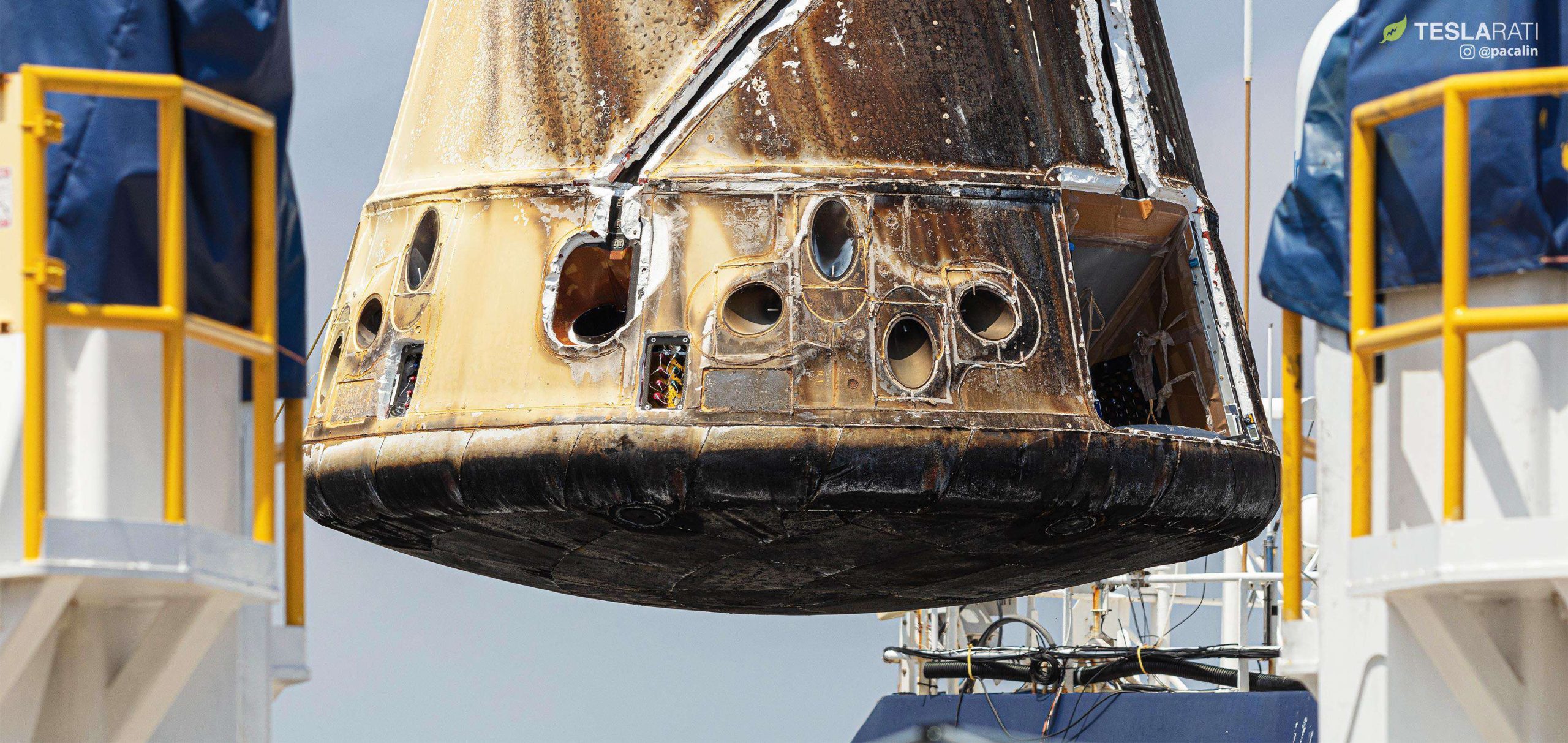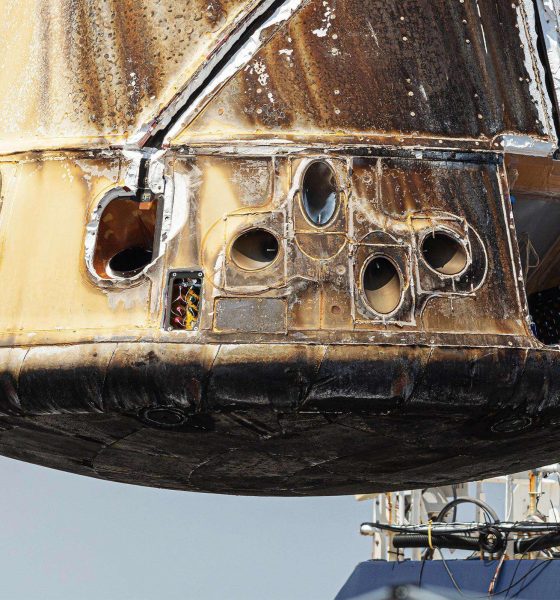

News
SpaceX Cargo Dragon capsule ends its second flawless trip to space and back
On June 4th, SpaceX Cargo Dragon capsule C113 departed from the International Space Station 250 miles (400 km) above Earth’s surface, tapped its thruster ‘brakes’, and reentered the atmosphere soon after.
After a month spent in orbit, the uncrewed Dragon returned more than 1900 kg (4200 lb) to Earth, currently the only operational spacecraft on Earth capable of doing so. Per usual, Cargo Dragon splashed down off the coast of California, was picked up by SpaceX vessel NRC Quest, and arrived at Port of Los Angeles a few hours later. Captured by Teslarati photographer Pauline Acalin in spectacular detail, C113’s second successful orbital mission serves as excellent foreshadowing for a follow-up launch – CRS-18 – that could come as soon as July 21st.
Orbital-class marshmallows
As per usual, Cargo Dragon received a healthy dose of charring during its orbital-velocity Earth reentry, barreling through the atmosphere at a blistering 7.7 km/s (4.8 mi/s, Mach 23). The capsule’s orientation during reentry is essentially seared into its hull by its own heat shield-generated plasma trail, creating the distinct dark-brown and black streaks visible in photos.
Although the visible wear and tear might look dramatic, the reality is SpaceX’s Dragon spacecraft are specifically designed to survive the ordeal of Earth reentry in excellent shape – the ablative heat shield takes nearly all (~99%) of the heating-related stress. Cargo Dragon (and Crew Dragon, for that matter) are just shy of encased in a cocoon of a different type of foam-like thermal protection material, visible as Dragon’s pearly white skin prior to reentry.
Teslarati photographer Pauline Acalin did an exceptional job of capturing the well-done SpaceX spacecraft’s return to shore in all its gritty, flight-proven glory, offering glimpses of Cargo Dragon’s Drago thrusters, parachute/drogue mortar, docking mechanism, and PICA-X heat shield.

CRS-18 crests the horizon
NASA and SpaceX have already scheduled Cargo Dragon’s next launch to the International Space Station on July 21st, a brisk 85 days after CRS-17’s successful launch. To make that date, preparations are already well underway and Cargo Dragon will likely ship from California within the next two weeks if it’s not already in Florida. Having successfully supported Cargo Dragon’s CRS-17 mission one month ago, Falcon 9 B1056.2 is scheduled to become the first flight-proven Block 5 booster to launch a dedicated NASA mission and the space agency is even open to using B1056 for a third time on CRS-19.

Beyond NASA’s Block 5 booster reuse milestone, there is also a good chance that CRS-18 will mark SpaceX’s first launch of an already twice-flown and refurbished Cargo Dragon capsule. Since CRS-10 (February 2017), just one of SpaceX’s seven subsequent Cargo Dragon launches has flown with a new capsule, and all of the company’s remaining CRS missions are expected to use refurbished spacecraft. Although one mystery Cargo Dragon capsule (C107) remains publicly unaccounted for, chances are quite good that CRS-18 will mark the first time a commercial space capsule has reached orbit three times.
Assuming SpaceX’s third refurbishment follows the fairly consistent two-year time scale of past Dragon reflights, Cargo Dragon C106 – the first Dragon SpaceX reused – will likely be CRS-18’s capsule.

Check out Teslarati’s Marketplace! We offer Tesla accessories, including for the Tesla Cybertruck and Tesla Model 3.

News
Tesla FSD fleet is nearing 7 billion total miles, including 2.5 billion city miles
As can be seen on Tesla’s official FSD webpage, vehicles equipped with the system have now navigated over 6.99 billion miles.

Tesla’s Full Self-Driving (Supervised) fleet is closing in on almost 7 billion total miles driven, as per data posted by the company on its official FSD webpage.
These figures hint at the massive scale of data fueling Tesla’s rapid FSD improvements, which have been quite notable as of late.
FSD mileage milestones
As can be seen on Tesla’s official FSD webpage, vehicles equipped with the system have now navigated over 6.99 billion miles. Tesla owner and avid FSD tester Whole Mars Catalog also shared a screenshot indicating that from the nearly 7 billion miles traveled by the FSD fleet, more than 2.5 billion miles were driven inside cities.
City miles are particularly valuable for complex urban scenarios like unprotected turns, pedestrian interactions, and traffic lights. This is also the difference-maker for FSD, as only complex solutions, such as Waymo’s self-driving taxis, operate similarly on inner-city streets. And even then, incidents such as the San Francisco blackouts have proven challenging for sensor-rich vehicles like Waymos.
Tesla’s data edge
Tesla has a number of advantages in the autonomous vehicle sector, one of which is the size of its fleet and the number of vehicles training FSD on real-world roads. Tesla’s nearly 7 billion FSD miles then allow the company to roll out updates that make its vehicles behave like they are being driven by experienced drivers, even if they are operating on their own.
So notable are Tesla’s improvements to FSD that NVIDIA Director of Robotics Jim Fan, after experiencing FSD v14, noted that the system is the first AI that passes what he described as a “Physical Turing Test.”
“Despite knowing exactly how robot learning works, I still find it magical watching the steering wheel turn by itself. First it feels surreal, next it becomes routine. Then, like the smartphone, taking it away actively hurts. This is how humanity gets rewired and glued to god-like technologies,” Fan wrote in a post on X.
News
Tesla starts showing how FSD will change lives in Europe
Local officials tested the system on narrow country roads and were impressed by FSD’s smooth, human-like driving, with some calling the service a game-changer for everyday life in areas that are far from urban centers.

Tesla has launched Europe’s first public shuttle service using Full Self-Driving (Supervised) in the rural Eifelkreis Bitburg-Prüm region of Germany, demonstrating how the technology can restore independence and mobility for people who struggle with limited transport options.
Local officials tested the system on narrow country roads and were impressed by FSD’s smooth, human-like driving, with some calling the service a game-changer for everyday life in areas that are far from urban centers.
Officials see real impact on rural residents
Arzfeld Mayor Johannes Kuhl and District Administrator Andreas Kruppert personally tested the Tesla shuttle service. This allowed them to see just how well FSD navigated winding lanes and rural roads confidently. Kruppert said, “Autonomous driving sounds like science fiction to many, but we simply see here that it works totally well in rural regions too.” Kuhl, for his part, also noted that FSD “feels like a very experienced driver.”
The pilot complements the area’s “Citizen Bus” program, which provides on-demand rides for elderly residents who can no longer drive themselves. Tesla Europe shared a video of a demonstration of the service, highlighting how FSD gives people their freedom back, even in places where public transport is not as prevalent.
What the Ministry for Economic Affairs and Transport says
Rhineland-Palatinate’s Minister Daniela Schmitt supported the project, praising the collaboration that made this “first of its kind in Europe” possible. As per the ministry, the rural rollout for the service shows FSD’s potential beyond major cities, and it delivers tangible benefits like grocery runs, doctor visits, and social connections for isolated residents.
“Reliable and flexible mobility is especially vital in rural areas. With the launch of a shuttle service using self-driving vehicles (FSD supervised) by Tesla in the Eifelkreis Bitburg-Prüm, an innovative pilot project is now getting underway that complements local community bus services. It is the first project of its kind in Europe.
“The result is a real gain for rural mobility: greater accessibility, more flexibility and tangible benefits for everyday life. A strong signal for innovation, cooperation and future-oriented mobility beyond urban centers,” the ministry wrote in a LinkedIn post.
News
Tesla China quietly posts Robotaxi-related job listing
Tesla China is currently seeking a Low Voltage Electrical Engineer to work on circuit board design for the company’s autonomous vehicles.

Tesla has posted a new job listing in Shanghai explicitly tied to its Robotaxi program, fueling speculation that the company is preparing to launch its dedicated autonomous ride-hailing service in China.
As noted in the listing, Tesla China is currently seeking a Low Voltage Electrical Engineer to work on circuit board design for the company’s autonomous vehicles.
Robotaxi-specific role
The listing, which was shared on social media platform X by industry watcher @tslaming, suggested that Tesla China is looking to fill the role urgently. The job listing itself specifically mentions that the person hired for the role will be working on the Low Voltage Hardware team, which would design the circuit boards that would serve as the nervous system of the Robotaxi.
Key tasks for the role, as indicated in the job listing, include collaboration with PCB layout, firmware, mechanical, program management, and validation teams, among other responsibilities. The role is based in Shanghai.
China Robotaxi launch
China represents a massive potential market for robotaxis, with its dense urban centers and supportive policies in select cities. Tesla has limited permission to roll out FSD in the country, though despite this, its vehicles have been hailed as among the best in the market when it comes to autonomous features. So far, at least, it appears that China supports Tesla’s FSD and Robotaxi rollout.
This was hinted at in November, when Tesla brought the Cybercab to the 8th China International Import Expo (CIIE) in Shanghai, marking the first time that the autonomous two-seater was brought to the Asia-Pacific region. The vehicle, despite not having a release date in China, received a significant amount of interest among the event’s attendees.














